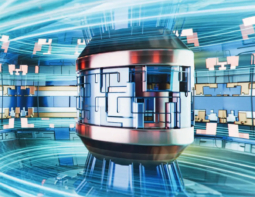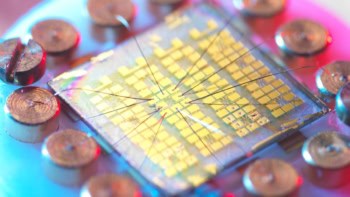
By levitating a tiny, nano-sized diamond using light, physicists in the US and Finland have created a controllable quantum system that has optical, mechanical and spin degrees of freedom. Based on a single “nitrogen vacancy” (NV) defect in the diamond, the system could be used in devices that measure extremely weak forces – or even to create “Schrödinger’s cat states”.
NV defects occur in diamond when two adjacent carbon atoms are replaced by a nitrogen atom and an empty lattice site. One type of NV (NV–) is of great interest to physicists building quantum devices because its spin state (–1, 0 or +1) can be determined very easily using light. Furthermore, NVs are well isolated from their surroundings, which means that their spin states – unlike those of most other solid-state systems – keep their quantum nature for relatively long times.
Multiple vacancies
This is not the first time that nanodiamonds have been levitated – back in 2013 Levi Neukirch, Nick Vamivakas and colleagues at the University of Rochester did so using an optical trap. In their experiment, which was done in air, laser light at another wavelength was used to determine the spin states of NVs in the diamond, which was tens of nanometres across. This was an important first step towards creating a “hybrid quantum system”, but the air meant that the nanodiamond could not be put into its lowest energy mechanical state, while the presence of multiple NVs meant that it could not be used as a single spin state either.
Now, however, the Rochester team has joined forces with Eva von Haartman at Åbo Akademi University to address both problems by levitating the single-NV nanodiamonds in a vacuum and showing that the mechanical motion of the diamond can be tracked using the spin of the NV. The team used irregularly shaped diamond nanoparticles about 40 nm across that were coated with silicon oxide to make them more spherical – which makes optical trapping easier. The particles were then trapped using light from a near-infrared laser focused onto a narrow region in a vacuum chamber at just 1 kPa – about 1% normal atmospheric pressure.
Red light, green light
The team trapped a nanoparticle with just one NV and read out its spin state by shining green laser light on it. Some of this is absorbed by the NV electron before being re-emitted as red light through photoluminescence. This process depends on the spin state of the NV, which makes the technique ideal for measuring NV spin.
When a nanoparticle is held in the optical trap at atmospheric pressure, its motion is random because of collisions with air molecules. However, as the air is pumped out of the chamber, the nanoparticle oscillates with simple harmonic motion at a frequency of about 250 kHz. By monitoring the intensity of the photoluminescent light, the team showed that the nanoparticle was indeed oscillating back and forth across the focal region of the green laser – with the photoluminescence at a maximum when the particle was at the centre of the focal region.
The team was also able to control the spin state of the NV using electron spin resonance (ESR), which involves firing a microwave signal at the nanoparticle and causing a transition between spin states. This transition involves a peak in the absorption of the microwaves at the transition energy, which was also observed by the team. Finally, the team studied the effect of an applied magnetic field on the NV spin. In the absence of an applied magnetic field, the +1 and –1 spin states have the same energy. However, when a magnetic field is applied, one state gains energy while the other loses it. This causes a splitting of the absorption peak into two peaks, which was also seen by the team.
Opposing forces
Having learned how to monitor the motion and spin state of the nanoparticle, the team now wants to find ways of manipulating the quantum properties of the system. This could involve, for example, applying a magnetic field such that an NV in the +1 state would feel a force in one direction, while an NV in the –1 state would feel a force in the opposite direction. Under the right experimental conditions, these opposing forces would put the entire nanoparticle into a quantum superposition of two mechanical states – analogous to the famous Schrödinger’s cat, which is in a superposition of being both dead and alive.
Another possible application for the system is an accelerometer that could detect tiny external forces by their effect on how the nanodiamond oscillates. But before the team can try such experiments, they must tackle the problem of the trapped nanoparticles surviving barely a minute or two in a vacuum before being completely degraded. The team believes that this happens because the particles are heated by the laser light but are unable to get rid of the heat through contact with air. The researchers had thought that the silicon-oxide coating would improve the robustness of the nanoparticles, but this was not the case and more work on this is needed.
The research is described in Nature Photonics.



